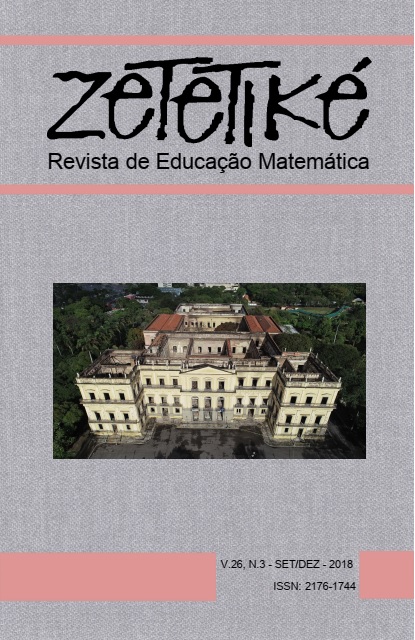Abstract
This article reports a research concerning a prospective teacher education experiment. The aim of this study is to
understand the contribution of exploratory tasks to the development of spatial reasoning and which are the
processes of spatial reasoning promoted. Data was gathered from audio and video records and the analysis
focused on the processes of constructing mental models, as well as inspecting, transforming and operating with
mental models. The study suggests that the type of tasks, the physical models made available and the
interactions in the classroom are relevant conditions to the activation of these processes. In respect to the tasks,
the enumeration of elements of the polyhedra and the establishment of relations and justifications promote the
processes of spatial reasoning; the physical models are important as a support, but its use should be limited; and
the collaborative work context favours the communication of reasoning and the spatial structuring of objects.
References
Atiyah, M. (1982). What is geometry? The 1982 Presidential Address. The Mathematical Gazette, 66(437), 179-184.
Battista, M. T. (2007). The development of geometric and spatial thinking. In F. K. Lester (Ed.), Second handbook of research on mathematics teaching and learning (pp. 843-908). Greenwich, CN: Information Age.
Battista, M. T. (2009). Highlights of research on learning school geometry. In T. V. Craine & R. Rubenstein (Eds.), Understanding geometry for a changing world (pp. 91-108). Reston, VA: NCTM.
Battista, M. T., & Clements, D. H. (1996). Students' understanding of three-dimensional rectangular arrays of cubes. Journal for Research in Mathematics Education, 27(3), 258-292.
Chapman, O. (2013). Investigating teachers’ knowledge for teaching mathematics. Journal of Mathematics Teacher Education, 16(4), 237-243.
Cobb, P., Confrey, J., diSessa, A., Lehrer, R., & Schauble, L. (2003). Design experiments in educational research. Educational Researcher, 32(1), 9–13.
CBMS (2000). Mathematical Education of Teachers Project. Washington, DC: American Mathematical Society.
CBMS (2012). Mathematical Education of Teachers II. Washington, DC: American Mathematical Society.
Clements, D. H., & Sarama, J. (2011). Early childhood teacher education: the case of geometry. Journal of mathematics teacher education, 14(2), 133-148.
Duval, R. (1999). Representation, vision and visualization: Cognitive functions in mathematical thinking. Basic issues for learning. In F. Hitt & M. Santos (Eds.), Proceedings of the 21st North American PME Conference, 1, 3-26.
Gutiérrez, A. (1996). Visualization in 3-dimensional geometry: In search of a framework. In L. Puig & A. Gutierrez (Eds.), Proceedings of the 20th PME International Conference, 1, 3-19.
Johnston-Wilder, S., & Mason, J. (Eds.). (2005). Developing thinking in geometry. London: Sage.
Jones, K., Mooney, C., & Harries, T. (2002). Trainee primary teachers’ knowledge of geometry for teaching. Proceedings of the British Society for Research into Learning Mathematics, 22(2), 95–100.
Jones, K., & Tzekaki, M. (2016). Research on the teaching and learning of geometry. In A. Gutiérrez, G. C. Leder & P. Boero (Eds.), The second handbook of research on the psychology of mathematics education (pp. 109-149). Rotterdam: Sense.
Kuzniak, A. (2013). Teaching and learning geometry and beyond… In B. Ubuz, Ç. Haser & M. A. Mariotti (Eds.), Proceedings of the eighth congress of the European Society for Research in Mathematics Education (pp. 33-49). Turkey: Ankara.
Malkevich, J. (2009). What is geometry? In T. V. Craine & R. Rubenstein (Eds.), Understanding geometry for a changing world (pp. 3-16). Reston, VA: NCTM.
Menezes, L., Serrazina, L., Fonseca, L., Ribeiro, A., Rodrigues, M. Vale, I., … Tempera, T. (2014). Conhecimento de geometria de alunos da licenciatura em Educação Básica. Atas do XXV Seminário de Investigação em Educação Matemática. Braga.
National Council of Teachers of Mathematics (NCTM) (1994). Normas profissionais para o ensino da Matemática. Lisboa: APM e IIE.
Ponte, J. P. (2005). Gestão curricular em Matemática. In GTI (Ed.), O professor e o desenvolvimento curricular (pp. 11-34). Lisboa: APM.
Ponte, J. P. & Chapman, O. (2008). Preservice mathematics teachers’ knowledge and development. In L. English (Ed.), Handbook of international research in mathematics education (2nd ed., pp. 225-263). New York, NY: Routledge.
Presmeg, N. C. (2006). Research on visualization in learning and teaching mathematics. In A. Gutiérrez, P. Boero (Eds.), Handbook of Research on the Psychology of Mathematics Education: Past, Present and Future (pp. 205-235). Rotterdam: Sense.
Projecto Matemática para Todos (s.d.). Investigações na sala de aula—propostas de trabalho. Lisboa: APM
Sinclair, N., Bussi, M. G. B., De Villiers, M., Jones, K., Kortenkamp, U., Leung, A., & Owens, K. (2016). Recent research on geometry education: An ICME-13 survey team report. ZDM Mathematics education, 48(5), 691-719.
Steele, M. D. (2013). Exploring the mathematical knowledge for teaching geometry and measurement through the design and use of rich assessment tasks. Journal of Mathematics Teacher Education, 16(4), 245-268.
Veloso, E. (1998). Geometria: Temas actuais. Lisboa: IIE.
Watson, A., & Mason, J. (2007). Taken-as-shared: A review of common assumptions about mathematical tasks in teacher education. Journal of Mathematics Teacher Education, 10(4), 205-215.
Whiteley, W., Sinclair, N. & Davis, B. (2015). What is spatial reasoning? In B. Davis & Spatial Reasoning Study Group. Spatial reasoning in the early years: Principles, assertions, and speculations (pp. 3-14). New York, NY: Routledge.

This work is licensed under a Creative Commons Attribution-NonCommercial-NoDerivatives 4.0 International License.
Copyright (c) 2018 Zetetike


